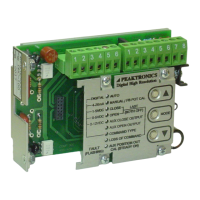ASAHI/AMERICA, INC 655 ANDOVER STREET LAWRENCE, MA. 01843 TELEPHONE 800-343-3618
Location: assembly/manuals Series 92 A/C Modulating Svc Manual Gen II Rev. A 11/15/19
Page 17 of 26
Loss of Command
When using 1-5V, 2-10V, 4-20mA, or a Digital input type for the command signal,
the DHC-100 will detect when the command signal is lost or out of range. A loss
of command condition is detected whenever the input is disconnected, the input
becomes less than 0.75V (for 1-5Vinput), 1.5V (for 2-10V input), or 3mA, or if the
input is connected backwards. An out of range condition is detected whenever
the input becomes greater than 5.25V (for 1-5V input), 10.5V (for 2-10V input), or
21mA. If the DHC-100 detects a loss of command , a fault will be indicated (see
FAULT INDICATORS), and the actuator will be moved to one of three preset
positions: the open position, the closed position, or the position last attained prior
to losing the command signal. The LOSS OF COMMAND function is used to set
the desired default position.
When the LOSS OF COMMAND function is selected, the adjust buttons and
are used to set the default position. The DHC-100 indicates the selected
default setting by flashing the Open function indicator for the open default posi-
tion, or it will flash the Close function indicator for the closed default position.
When neither indicator is on, then the "last position" default is selected.
When a 0-5V or 0-10V command signal is used, a loss of command signal
cannot be detected. Therefore, if the unit is configured for a 0-5V or 0-10V
command signal (see COMMAND TYPE), the MODE button will not select the
LOSS OF COMMAND function. However, the DHC-100 can detect when a 0-5V
or 0-10V command signal is out of range (i.e., greater than 5.25V or greater than
10.5V), or connected backwards. When an out of range condition is detected for
a 0-5V or 0-10V input, the motor is turned off (leaving the actuator is its “last
position”) and a fault will be indicated (see FAULT INDICATORS).
Position Out Cal
The POSITION OUT CAL function is used to calibrate an optional feedback
transmitter output. An appropriate transmitter option module is required to use
this feature. When the POSITION OUT CAL function is first selected (by pressing
the MODE button while in the LOSS OF COMMAND function), the CLOSE
indicator will flash, and the voltage or current associated with the closed position
will appear at the option module output. If desired, the output can be adjusted
(using the adjust buttons and ) to any value from 0-10V (for a voltage
output) or 4 to 20mA (for a current output). The new setting is then saved when
the MODE button is pressed.
Pressing the MODE button again will leave the unit in the POSITION OUT CAL
function except that the OPEN indicator will flash, and the output voltage or
current associated with the open position will appear at the option module output.
Like the closed setting, the output can be adjusted to any voltage (from 0-10V) or
current (from 4-20mA), and the new setting is then associated with the open
position.

